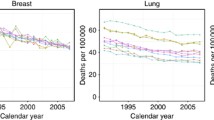Abstract
Survival, i.e. the time from report to cancer registry to death was studied for 591,456 cases of cancer diagnosedin vivo from 1960 to 1984. Ten years survival increased from 35 to 40%. Survival rates for women were higher than for men. Since 10 years survival almost suggests cure, lead time bias is assumed not to be a major factor. Nor are relaxed histological criteria, detecting non-fatal tumors, intensified microscopic examination, changes in the relative frequency of cancer types, or increasing numbers of elderly patients assumed to be major artefacts. In contrast, improved socio-economic and health status are. Early detection also improves survival in some cancer types.
Similar content being viewed by others
References
Adami H-Oet al.: Increasing survival trend after cancer diagnosis in Sweden: 1960–1984.J natn Cancer Inst 81, 1640–1647 (1989).
Mattsson B.: Cancer registration in Sweden. Studies on completeness and validity of incidence and mortality registers. PhD dissertation. University of Stockholm, Sweden (1984).
Hakulinen Tet al.:Suomalaisten syöpä. Alueittainen kehitys 1954–2008. Suomen Syöpärekisteri, Syöpätautien tutkimussäätö, Helsinki (1989).
Philipp R, Hastings A, Briggs J, Sizer J.: are malignant melanoma time trends explained by changes in histopathological criteria for classifying pigmented skin lesions?J Epidem Comm Hlth 42, 14–16 (1987).
Ringberg A. Palmer B, Linell F: The contralateral breast at reconstructive surgery after breast cancer Operation — a histopathological study.Breast Cancer Res Treatment 2, 151–161 (1982).
Pontén J: Abnormal cell growth (neoplasia) and aging, in Finch C E and Hayflick L (eds):Handbook of the Biology of Aging, pp. 536–650. New York, Van Norstarnd Reinhold Company (1977).
Fransilla K O, Hanach H R: Occult papillary carcinoma of the thyroid in children and young adults.Cancer 58, 715–719, (1986).
Pontén J and Larsson L-G: Breast cancer. Critical overviews of natural history, etiology, molecular biology and screening by mammography.Int J Cancer 5, (1990).
Hansson L-E, Bergström R, Sparén P and Adami H-O: The decline in the incidence of stomach cancer in Sweden 1960–1984: A birth cohort phenomenon.Int J Cancer 47, 499–503 (1991).
Devesa S A et al: Cancer incidence and mortality trends among whites in the United States, 1947-84.J natn Cancer but 79, 701–770 (1987).
Tomatis L (ed):Cancer: Causes, Occurrence and Control, IARC Scientific Publications No. 100. International Agency for Research on Cancer, Lyon (1990).
Young J L Jr, Ries L G, Pollack E S: Cancer patient survival among ethnic groups in the United States.J natn Cancer Inst 73, 341–352 (1984).
Munoz N, Correa P, Cuello C, Duque E: Histologic types of gastric carcinoma in high- and low-risk areas.Int J Cancer 3, 809–815 (1968).
Bergkvist L, Adami H-O, Persson I: Prognosis after breast cancer diagnosed in women exposed to estrogen and estrogen-progestogen replacement therapyAm J Epidemiol 130, 221–228 (1989).
Collins J, Doner A, Allen L H et al: Oestrogen use and survival in endometrial cancer.Lancet 2, 461–464 (1980).
Stemmermann G N, Brown C: A survival study of intestinal and diffuse types of gastric carcinoma.Cancer 33, 1190–1195 (1974).
Annual report on the results of treatment in gynecological cancer, FIGO. Ed Folke Pettersson, Panorama Press AB, Stockholm, 1988.
Shafir R, Hiss J, Tsur D, Bubis J J: The thin malignant melanoma. Changing patterns of epidemiology and treatment.Cancer 50, 817–819 (1982).
Phillips RKS, Hittinger R, Blesowsky L, Fry J S and Fielding L P: Large bowel cancer: Surgical pathology and its relationship to survival.Br J Surg 71, 604–610 (1984).
Bailar J C III, Smith E M: Progress against cancer?N Engl J Med 314, 1226–1232 (1986).
Rutqvist L-E, Mattsson B, Signomklao T: Cancer mortality trends in Sweden 1960–1986.Acta Oncol 28, 771 (1989).
Doll R: Progress against cancer: Are we winning the war?Acta Oncol 28, 611–621 (1989).
Hakulinen T, Tenkanen L: Regression analysis of relative survival rates.Appl Stat 36, 309–317 (1987).
Lenner P: The excess mortality rate. A useful concept in cancer epidemiology.Acta Oncol 29, 573–576 (1990).
Author information
Authors and Affiliations
Rights and permissions
About this article
Cite this article
Pontén, J., Adami, HO. & Sparén, P. Trends in cancer survival and mortality rates. Med. Oncol. & Tumor Pharmacother. 8, 147–153 (1991). https://doi.org/10.1007/BF02987172
Received:
Accepted:
Issue Date:
DOI: https://doi.org/10.1007/BF02987172




